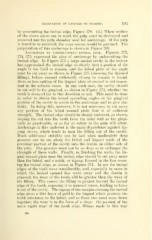Page 435 - My FlipBook
P. 435
EXCAVATION OF CAVITIES BY CLASSES. 193
by overcutting the incisal edge, Figure 278. (3.) When neither
of the al)Ove plans can be used, the pulp must be destroyed and
removed and the pulp chamber used for anchorage. If the pulp
is found to be involved, the same course would be pursued. The
preparation of this anchorage is shown in Figure 269.
Anchorage by undercutting incisal edge. Figures 273,
274, 275, represent the plan of anchorage by undercutting the
incisal edge. In Figure 273 a large mesial cavity in the incisor
has approached the incisal edge so closely that a portion of the
angle is too frail to remain, and the labial plate of the angle
must be cut away as shown in Figure 275 (showing the finished
filling), before enamel sufficiently strong to remain is found.
More or less cutting of the lingual plate of enamel is not impor-
tant in the esthetic sense. In any such case, the cavity should
be cut well to the gingival, as shown in Figure 274, whether the
tooth is decayed far in this direction or not. This must be done
in order to obtain the broad spreading angles at the gingival
portion of the cavity to assist in the anchorage and to give sta-
bility. In doing this, however, it is not necessary to cut away
any portion of the labial enamel plate that is of sufficient
strength. The incisal edge should be deeply undercut, as shown,
sloping the cut into the tooth from the axial wall as far gingi-
vally as practicable, or as far as safety to the pulp will allow.
Anchorage in this undercut is the main dependence against tip-
ping stress, which tends to turn the filling out of the cavity.
Much additional stability can be had when moderately deep
grooves can be cut along the labial and lingual walls of the
proximal portion of the cavity into the dentin on either side of
the pulp. The grooves must not be so deep as to endanger the
strength of these walls. Finally, in finishing the walls, the lin-
gual enamel jilate near the incisal edge should be cut away more
than the labial, and a notch, or zigzag, formed in the line cross-
ing the incisal edge, as shown in Figure 274. In use the incisal
edges of the teeth wear considerably, and, especially in cases in
which the incisal enamel has worn away and the dentin is
exposed, the wear of the tooth will be greater than the wear of
the filling. This causes the filling to project beyond the incisal
edge of the tooth, exposing it to imusual stress, tending to force
it out of the cavity. The zigzag of the margin crossing the incisal
edge gives a thin layer of gold to the lingual which protects the
tooth substance to the labial, and as these two must wear down
together, the wear is in the form of a slope. On account of the
more rapid wear of the tooth edge, fillings made in this way


